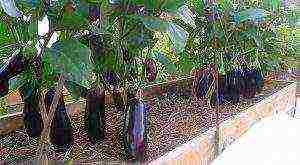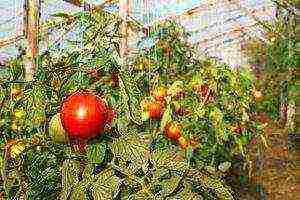Content
- 1 Description and characteristics
- 2 How sweet corn differs from regular corn
- 3 The best varieties
- 4 Landing rules
- 5 Cultivation and care technology
- 6 Diseases and pests
- 7 Corn is the slender queen of the fields
- 8 Description and external characteristics
- 9 Sweet corn varieties
- 10 Spirit
- 11 Dobrynya
- 12 Gourmet 121
- 13 Ice nectar
- 14 Sundance
- 15 Early Gold 401
- 16 Toothed corn: description and varieties
- 17 Odessa 10
- 18 Sterling
- 19 Flint corn: characteristics of varieties
- 20 Voronezh 80
- 21 Voronezh 76
- 22 Severodakot
- 23 Popcorn: Popcorn Varieties
- 24 Volcano
- 25 Oerlikon
- 26 Other types of corn
- 27 Fashionable novelty - Hopi corn
- 28 Fodder maize varieties
- 29 Landing rules
- 30 Plant feeding
- 31 Care features
Everyone knows about corn, and there is no person who would not love it in one form or another. Fresh, boiled, frozen, canned grains, corn porridge, and other types of healthy and tasty cereals.
The sugar corn variety has found its admirers all over the world. Many gardeners are happy to grow it on their own.
Description and characteristics
This is an annual cereal, quite patiently related to a difficult climate, different soils, and undemanding to care, a tall plant from one and a half to three meters. Differs in the presence of male and female flowers on one stem. The root of corn reaches a length of more than one meter, has a very strong structure, fibrous.
It is a high-yield cereal rich in oils, carbohydrates and proteins that are easily absorbed by the human body.
Vitamins of group B, PP, C, carotene, as well as tryptophan and lysine, contribute to the rapid absorption of trace elements and the breakdown of carbohydrates.
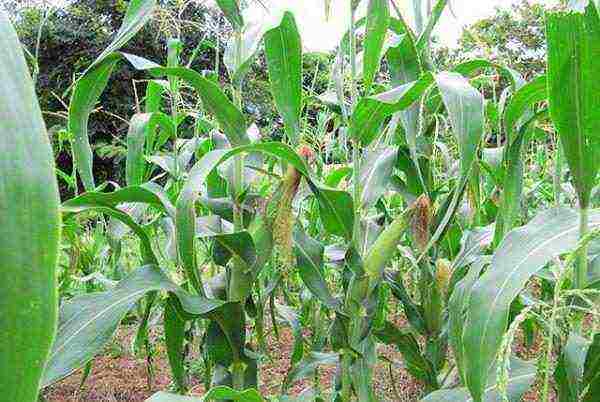 This is how corn grows
This is how corn grows
Ripe ears usually reach 16 - 25 cm, have a dense structure, bright yellow seeds, tightly adjacent to each other. The taste is delicate and sweet, milky.
How sweet corn differs from regular corn
Distinguishing the seeds of regular feed corn from sweet corn is impossible unless you have similar experience. But, the seeds still have external differences:
- Fodder corn seeds are darker;
- Sugar varieties are somewhat smaller;
- When boiled, sugar varieties swell faster and become tender;
- Even dry seeds, when bitten through, are sweeter in sweet corn.
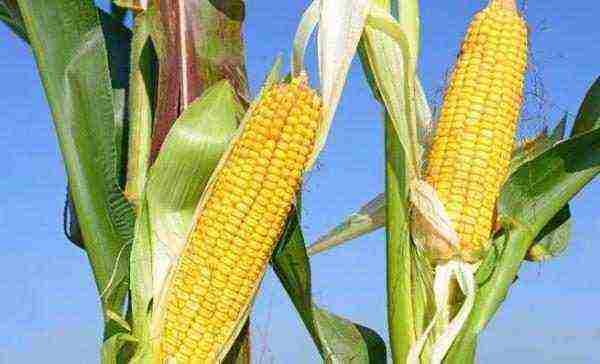 It's time to harvest
It's time to harvest
Corn on the cob can be distinguished by the following characteristics:
- The ear is more rounded, barrel-shaped, with a blunt end;
- The grains are lighter, milky,
- If you crush a grain between your fingers, it practically bursts;
- Even not thermally processed, tastes sweeter, and fodder is difficult to bite;
- When cooking, it is ready in 10 minutes, and the feed will be very tough in half an hour.
Overripe sugar grains are much darker than young ones and therefore can be considered fodder. The most correct test is “by the tooth”.
Sweet corn is healthier and tastier than conventional forage varieties. The complex of minerals and light sugars is ideally balanced in it. The low level of starch allows you to feast on it even on a diet.
The fodder varieties are tasteless, require prolonged heat treatment, and have very tough grains.
The best varieties
There are over 500 sugar varieties, and everyone will surely find the best one for themselves.
Important: The early varieties are suitable for more severe climates, as they have time to ripen before the cold weather, and the later ones for the southern latitudes are the most productive.
Dobrynya
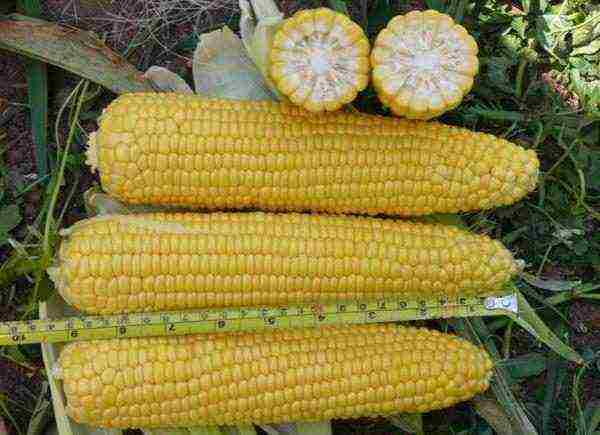 Sweet corn dobrynya grade
Sweet corn dobrynya grade
An early maturing variety, famous for its taste. Delicate grains, milky sweetness. Very fast and friendly germination of seeds, undemanding care.You can plant seedlings or seeds as soon as a stable temperature above 10 degrees is established.
The plant is up to 170 cm high, 70 days after sowing, the grains are filled with maturity and are ready for consumption.
Spirit
One of the varieties most beloved by gardeners. Up to 2 meters high, with 20 centimeter cobs, very sweet and juicy grains. Ideal both for boiled consumption and for preservation.
Seeds are sown in April, and in May they are already planted in the ground. Reaches full ripeness in 2 months.
Ice nectar
Late-ripening super-sugar grade. It reaches a height of 2.5 m. It is thermophilic, picky about watering and soil. Afraid of sudden changes in temperature. Maturity occurs between 80 and 90 days. Suitable for all types of use.
Gourmet 121
One of the earliest, high-yield sugar varieties. After 70 days, it gives a friendly harvest of grains of milk ripeness. Rich in flavor and disease resistance.
It is thermophilic during the seedling period, but under the condition of hardening the sprouts, it quickly adapts.
Landing rules
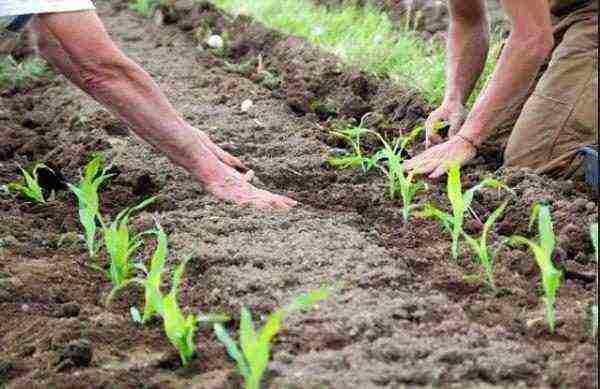 We plant corn in open ground
We plant corn in open ground
Observing simple conditions, gardeners and farmers receive a rich harvest. It is important to consider several principles:
- Prepare the soil in the fall before frost - dig thoroughly, remove weeds.
- When planting seeds in open ground, you should not do this earlier than mid-May. Seedlings should not appear at temperatures below 10 degrees.
- When planting seedlings, in April it is necessary to prepare the seeds: lay them out for one day on the sunny side on a windowsill or in a greenhouse, then hold them for about an hour in cool water and rinse.
- Seeds are planted in separate pots, 2 pcs. Moisten the soil well, cover with a transparent film until shoots appear.
Cultivation and care technology
The cultivation technology is almost the same as conventional varieties. When the first shoots appear:
- it is necessary to loosen the soil after each watering;
- prevent the soil from drying out;
- weed weeds;
- monitor the appearance of painful plants and remove them in a timely manner.
Important: in the process of forming the cob, you need to carefully consider watering, since the size of the cob and the sweetness of the grains directly depends on the quality of watering.
Top dressing:
- After the appearance of the first five leaves, it is necessary to fertilize with potash fertilizers;
- If the leaves have a light shade, turn yellow a little, add nitrogen fertilizers when watering;
- If the edges of the leaves look scorched, the plant is clearly deficient in potassium.
Re-feeding should be carried out not earlier than the beginning of the formation of the peduncle.
Diseases and pests
The most common diseases are:
Fusarium
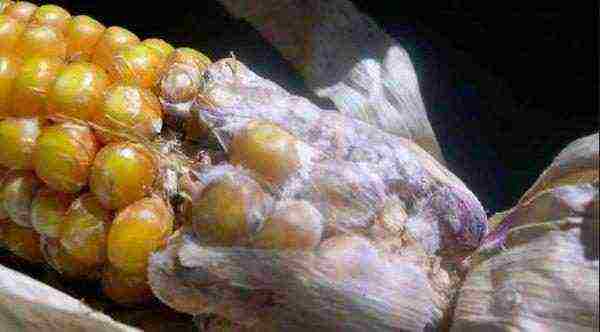 Corn disease - fusarium on the cob
Corn disease - fusarium on the cob
Fungal disease. It appears most often during periods of excessive moisture and affects already ripe ears. The grains acquire a light bloom and begin to rot. It is important to check the crop and remove diseased plants.... After harvest, they are burned.
Stem rot
During the growth period, dark spots are found on the lower part of the stem. The ear is also affected, the growth of the plant slows down. Only burning diseased plants will help. In the fall, it is necessary to burn all the leaves and stems, change the planting site the next year, or pickle with fungicides.
Corn rust
Bright red spots on green leaves on the underside. A fungal disease in which spores form on the leaves. For prevention, seedlings are treated with furingicide
Sugar maize is an excellent grain. Its benefits are undeniable, and if you decide to grow it yourself on your land, choose varieties based on the location of the site, your priorities and wishes. And on your table all year round will be these sweet golden grains in any form.
Sweet corn is one of the most ancient cereals, annual crops cultivated by humans for food and fodder purposes.
The popularity and demand for sweet corn is "off scale", it is used for table purposes as a main dish, added to salads, and canned.
With a sweet taste, boiled sweet corn cobs are loved by both adults and children. In addition to its pleasant taste and high satiety, the product contains a number of vitamins and minerals, as well as a huge supply of fiber. Sugar corn is a healthy and highly nutritious product that any novice gardener can grow.
The content of the article:
- Sugar corn - description of the culture
- Sweet corn varieties
- Growing sweet corn: where, when and how to plant
- The main rules for caring for corn
- Pests and diseases of sweet corn
Sugar corn - description of the culture
The culture is of an average level of complexity, it cannot be said that corn is an unpretentious plant, in order to get a high yield and a "rammed" ear, you will have to try.
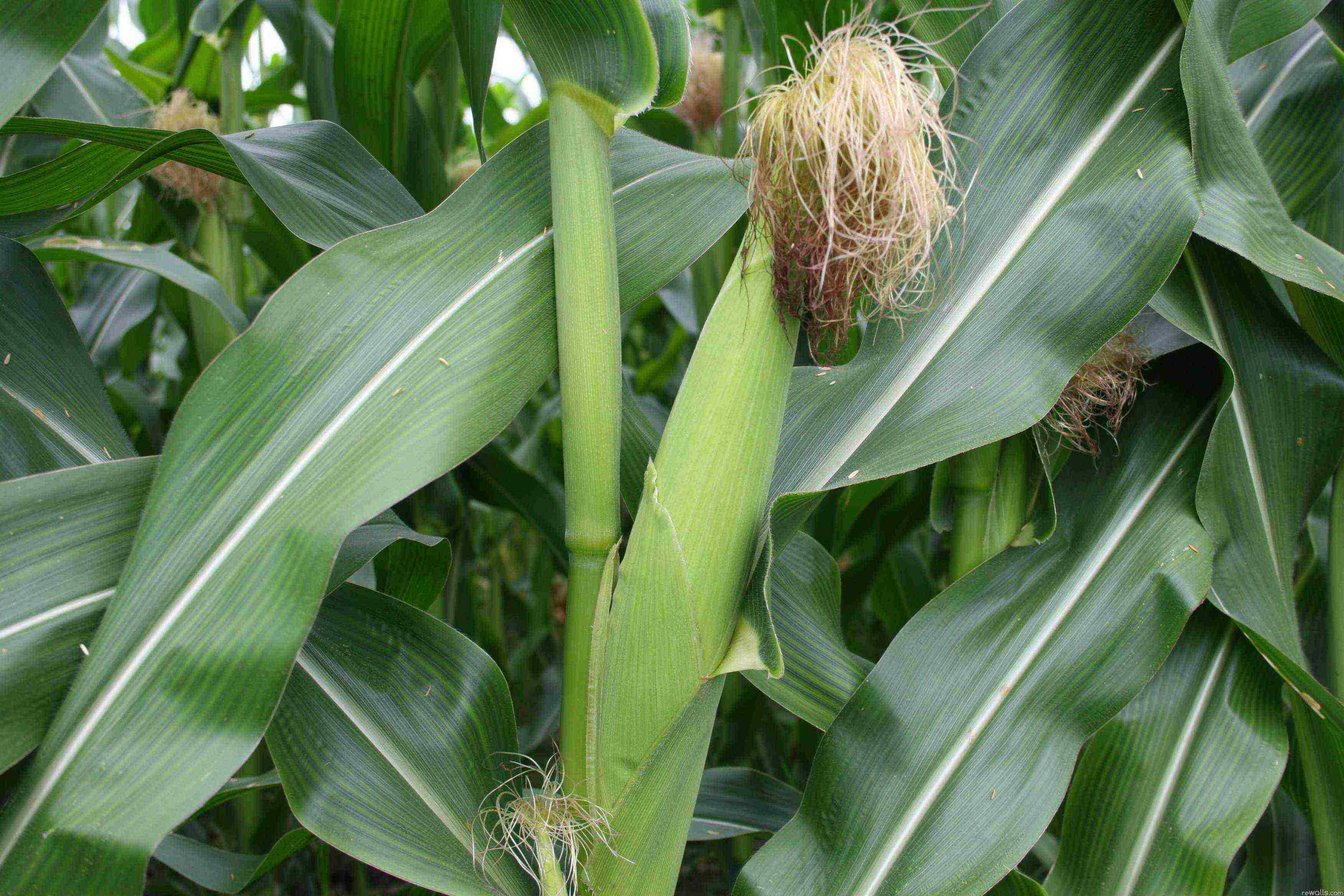 For development, the plant needs sunlight, sweet corn blooms with a short day, about a week earlier.
For development, the plant needs sunlight, sweet corn blooms with a short day, about a week earlier.
Frequent sowing of corn kernels will lead to lower yields in the future.
As for the root system, it is developed quite well and powerfully, it lies at a depth of a meter and deeper. The stem for a more dense strengthening in the soil, often produces additional roots, which contribute not only to stability, but also to better absorption of nutrients and moisture.
The erect stem of the plant grows up to 3.5 meters, has long, wide, pointed to the top leaves with parallel veins. Distinguish between male and female specimens by the location of inflorescences, in female maize they are located in the leaf axil, and male ones have the appearance of a panicle.
The cob weight averages about 350-450 grams. At the initial stage of maturity, it has a milky hue, and tender pulp, when fully ripe, the grains turn yellow and coarse.
 Corn seeds begin to germinate at a temperature of +11 ° C., And the first shoots will appear when the ground warms up enough. Early sowing performed poorly in terms of germination. Seedlings appear rare and sick. The most favorable temperature for the growth and development of the ear is + 23-28 ° C. The ripening of the sweet corn cob depends on the plant variety and growing conditions, usually the end of August, the beginning of September.
Corn seeds begin to germinate at a temperature of +11 ° C., And the first shoots will appear when the ground warms up enough. Early sowing performed poorly in terms of germination. Seedlings appear rare and sick. The most favorable temperature for the growth and development of the ear is + 23-28 ° C. The ripening of the sweet corn cob depends on the plant variety and growing conditions, usually the end of August, the beginning of September.
Sweet corn varieties
The most popular varieties of sweet corn preferred by summer residents and industrialists are:
Sugar corn variety Spirit
One of the new generation hybrids, grown in all regions of the country, gives impressive yields of large ears, with bright yellow, delicate grains. The plant is tall, early ripening cobs, weighing from 350 g., In length from 22 cm. The variety is used for table purposes, belongs to the dessert species. The boiled cob tastes sweet, juicy, contains a high percentage of sugar, and is not recommended for people with diabetes.
Sweet corn variety Delicacy
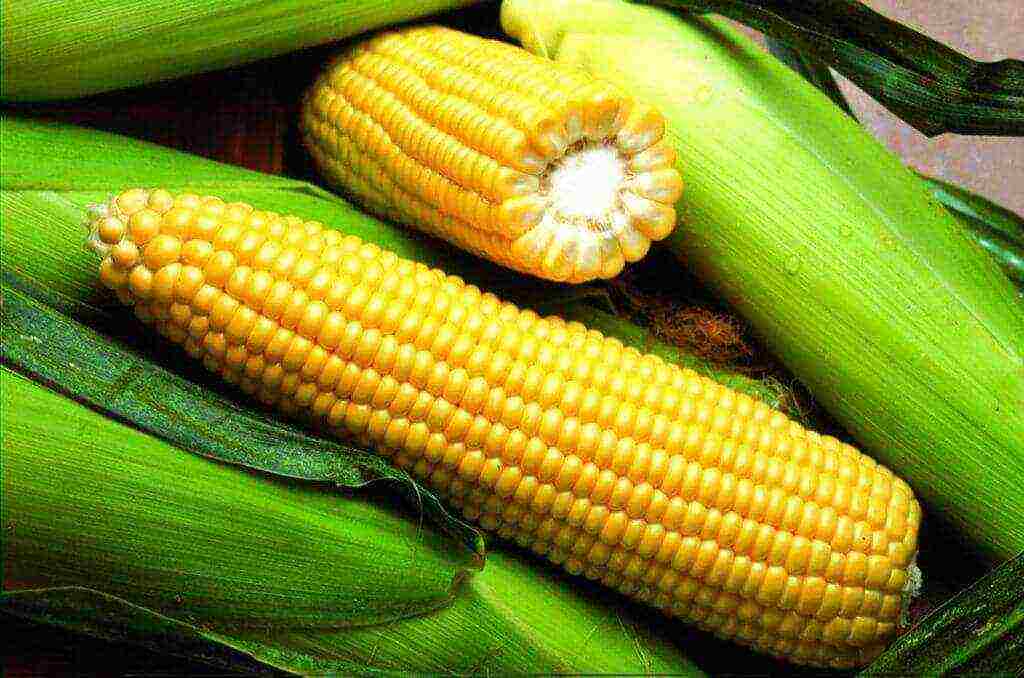 The variety was bred at the Sinilnikovskaya breeding station, belongs to the early maturing varieties, ripens in an average of 2.5 months.
The variety was bred at the Sinilnikovskaya breeding station, belongs to the early maturing varieties, ripens in an average of 2.5 months.
The medium-sized stem reaches a height of one and a half to two meters, gives ears weighing about 300 grams, cone-shaped about 17 cm. 100 grams. grains of sweet corn varieties Delicatessen contain 3 grams of fiber, 4.5% sugar, 5.6% protein. 2000 grains have a mass of 600 gr.
The taste of the delicacy variety fully justifies its name, the grains are sweet and juicy, it is widely used for table purposes, canned, pickled, boiled, frozen.
Variety Early gold 401
The variety is of medium ripening period, fully ripens in three months. Possesses high resistance to decay.
It tolerates short-term drought satisfactorily. The mass of one ear reaches 200 grams. Good taste characteristics.
Sweet corn Gourmet 121
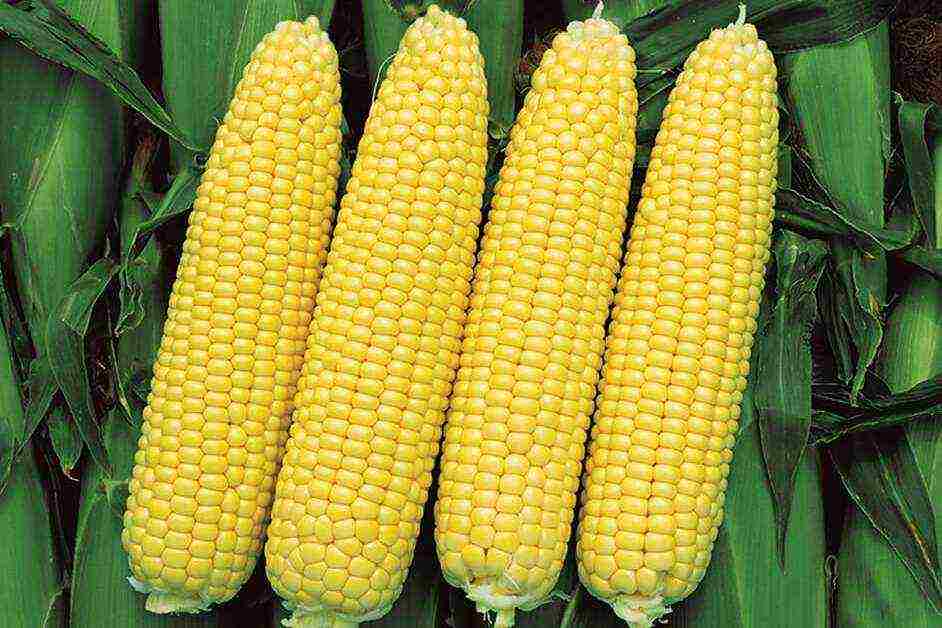 A stable, light-loving gourmet variety.Early ripeness implies the ripening of the cob already 65 days after planting, which is quite suitable for consumption. The plant is not tall, up to one and a half meters in height. The length of a mature ear is about 18 cm.
A stable, light-loving gourmet variety.Early ripeness implies the ripening of the cob already 65 days after planting, which is quite suitable for consumption. The plant is not tall, up to one and a half meters in height. The length of a mature ear is about 18 cm.
Often the variety is used in canning and consumed in its original boiled form.
Corn Sandas
The plant is not tall, the cobs are large, about 19 cm long. The ripening period is early, the harvest of milk cobs can be obtained 70 days after planting. The variety is suitable for conservation, it is used for table purposes.
Dobrynya variety
Hybrid variety of sweet corn, early maturing, dessert.
Reaches ripeness 65-75 days after sowing. Gives good yields of large ears. The boiled ear tastes sweet and tender. Dobrynya grows up to 180 cm in height, is unpretentious and resistant to fungal diseases. Great for canning.
Megaton
 High-yielding, mid-season sweet corn variety. The plant is long, about 2 m. The ears are formed on a short stalk, cone-shaped and large yellow grains. Wears a dining destination. Greens are used for forage purposes.
High-yielding, mid-season sweet corn variety. The plant is long, about 2 m. The ears are formed on a short stalk, cone-shaped and large yellow grains. Wears a dining destination. Greens are used for forage purposes.
Ice Nectar
Taste characteristics are high, the variety is resistant to temperature extremes. It is used for dessert purposes and is considered one of the sweetest varieties. The cobs are large and long, reaching a length of 23 cm.
Sweet variety Trophy
Hybrid sweet corn with excellent taste.
The dessert purpose of the hybrid is due to the sweet taste and delicate pulp of the fruit. The cobs are 20-23 cm long, with medium-sized grains. Gives high, early yields, subject to agricultural technology. It is used boiled and canned.
 Challenger variety
Challenger variety
A hybrid of medium ripeness. Super sweet look. Ripens three months after sowing. It is resistant to late blight and rust damage. Produces good yields with minimal effort. The cobs are large, up to 22 cm, with good keeping quality. The grains are medium in size, delicate in taste.
Hybrid variety Sweet Nugget
Early ripening, sweet taste, delicate grains, large ears - can be attributed to the advantages of this variety. The ear is ready for use as early as 65 days after sowing the crop. Large grains are great for canning. For the release of super early dessert corn, the variety is irreplaceable.
Sunrise
Super-sweet variety, early ripening. An ear of milk can be harvested as early as 2 months after planting. The plant is undersized, but this does not prevent it from producing large fruits "stuffed" with grains. The cob sizes vary from 19 to 23 cm.
It is intended for use in any form.
Growing sweet corn: where, when and how to plant
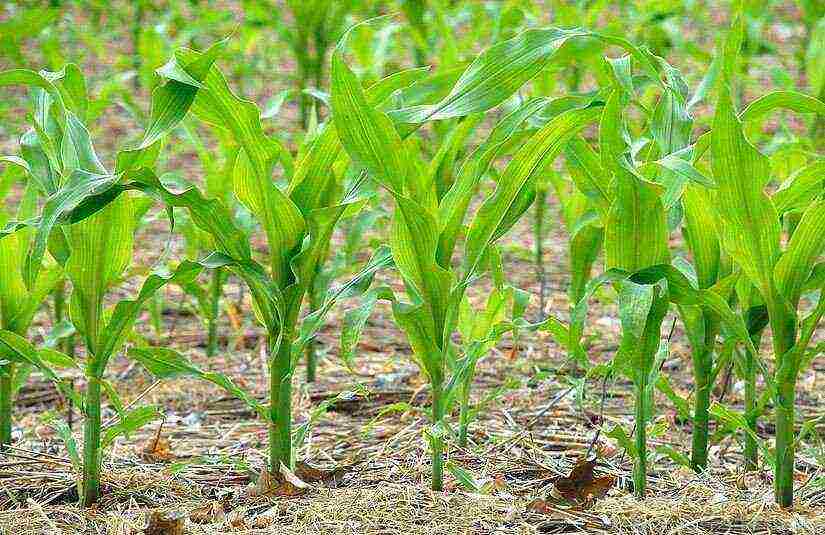 The sweet corn plant is not capricious, but whimsical. The culture loves sunlight and regular watering, for the formation of a large, healthy cob, full of grains, the plant needs fertilizing and fertilization. You can start planting corn in early May (southern regions of the country) and late spring (middle zone of Russia).
The sweet corn plant is not capricious, but whimsical. The culture loves sunlight and regular watering, for the formation of a large, healthy cob, full of grains, the plant needs fertilizing and fertilization. You can start planting corn in early May (southern regions of the country) and late spring (middle zone of Russia).
The right choice of sweet corn variety that meets your needs and does not contradict your varietal "needs" is considered important.
Choose a site that is well lit, protected from the wind.
The soil for planting sweet corn should be enriched and aerated. Swampy soils are destructive for corn, however, as well as for most cultivated plants.
Clogged, heavy, scanty soils must be tidied up before planting. In heavy (loamy and black earth) soils, add peat, sand and organic matter in a bucket per square meter, acidic soils - lime, sandy soils enrich with organic matter about 5-7 kg. per sq.m. and turf soil, 3 buckets for each "square" of the site. In addition to the above actions, the site is dug onto a shovel bayonet, harrowed without leaving large boulders.
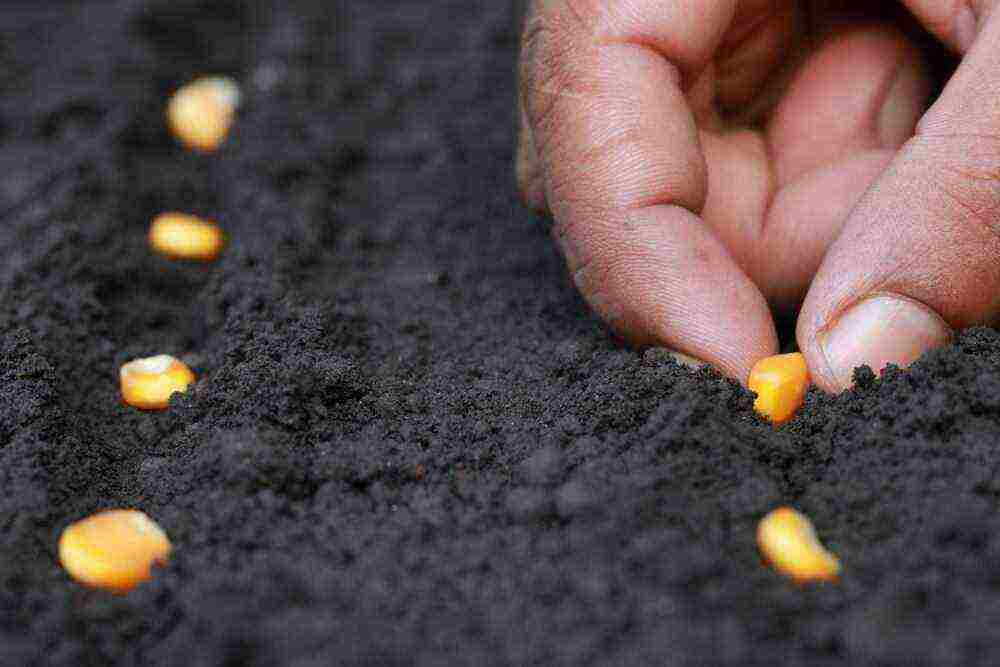 The predecessors for sweet corn in the crop rotation can be tuber crops, legumes, and tomatoes.In addition to these, the culture gets along with melons and cabbage.
The predecessors for sweet corn in the crop rotation can be tuber crops, legumes, and tomatoes.In addition to these, the culture gets along with melons and cabbage.
After you have prepared the soil of your site for sowing (applied organic and potash fertilizers, dug up and harrowed), you can start calibrating corn grains, dressing and sowing.
Pay attention to the grain size and allow large and whole sweet corn seeds to be planted. The grain germination test is carried out by soaking corn seeds in a weak saline solution, only the grains that have settled to the bottom will germinate in the future.
Pre-dressing the corn seed will protect it from fungal infections. The safest solution is a strong manganese solution and soak for ten minutes.
In the formed beds 8-7 cm deep, in 10-15 cm increments, grains are laid out and sprinkled. An adjacent garden bed is placed at 40 cm for better cross-pollination.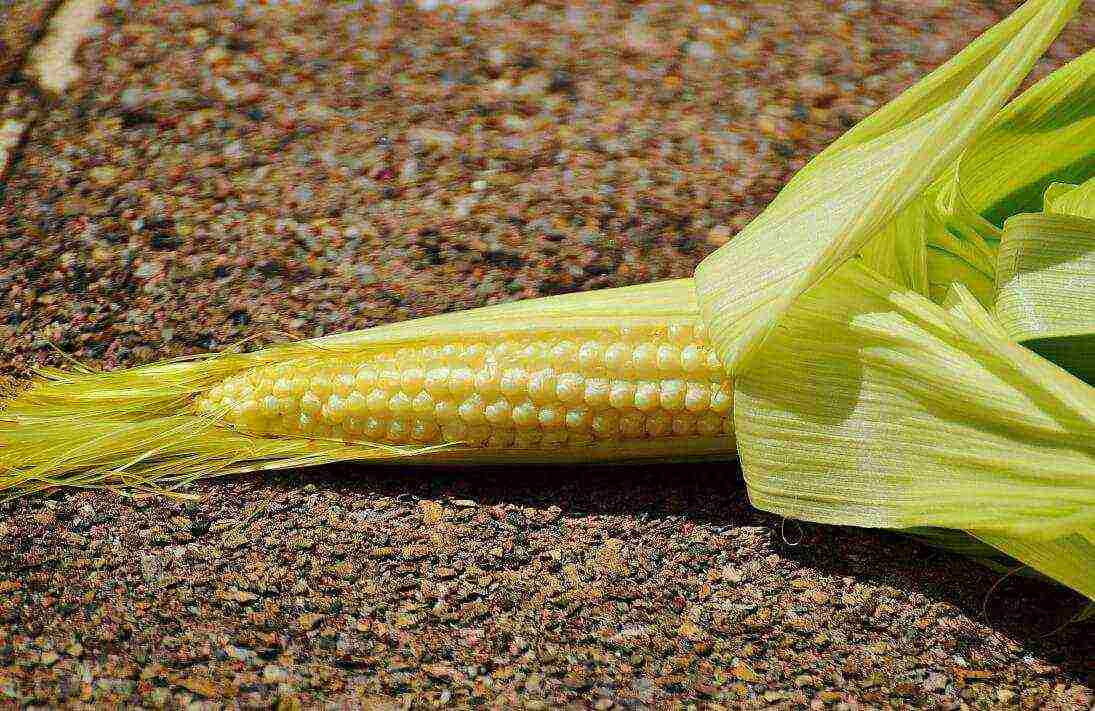 In addition to the linear planting method, sweet corn seeds can be planted using the square nest method. The plot is divided into squares and holes are formed, 9-11 cm, grains are planted in the recesses and covered with soil, the surface is mulched to retain moisture.
In addition to the linear planting method, sweet corn seeds can be planted using the square nest method. The plot is divided into squares and holes are formed, 9-11 cm, grains are planted in the recesses and covered with soil, the surface is mulched to retain moisture.
Many gardeners practice the method of planting corn seedlings. The cultivation of sweet corn is carried out at home. In early spring, corn grains are planted in prepared containers with a substrate, and they are waiting for shoots, and after the onset of heat, the seedlings are planted in open ground.
The main rules for caring for corn
The rapid growth of corn begins with the appearance of the first node on the plant. Before the beginning of flowering, the plant grows up to 11 cm per day, after which the forces are diverted to the laying and growth of the ears.
Corn needs watering, weeding, feeding and hilling.
A good ear can only be obtained with abundant watering, two or three times a week.
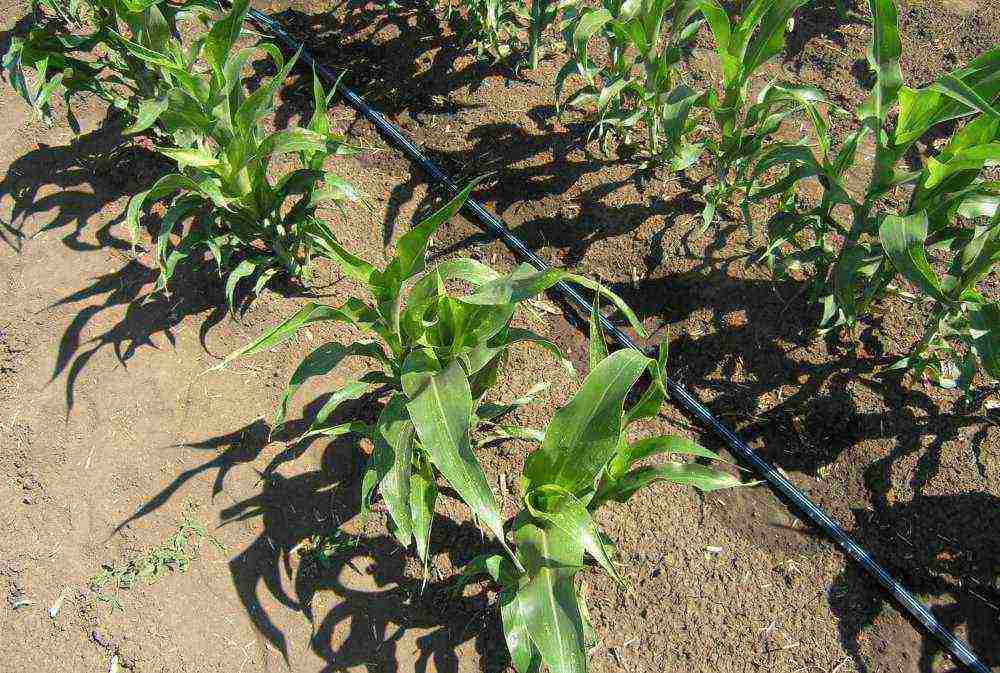
Hilling and loosening of the soil is carried out for better aeration of the root system and the emergence of additional roots.
Young shoots are loosened very carefully so as not to damage.
In order for the plant to grow in full force, and the harvest to delight you with large cobs, you need top dressing. At the initial stage of the growing season, nitrogen is introduced, it stimulates the growth of the plant. A week after applying nitrogen, feed with phosphorus, it is necessary for the formation of a large and printed cob.
Potash fertilizers are applied together with phosphorus, they reduce the risks of plant lodging and strengthen the root system.
The best option for top dressing can be called the introduction of nitroammofoska and compost, at the beginning of the growing season of the plant and at the stage of ear formation.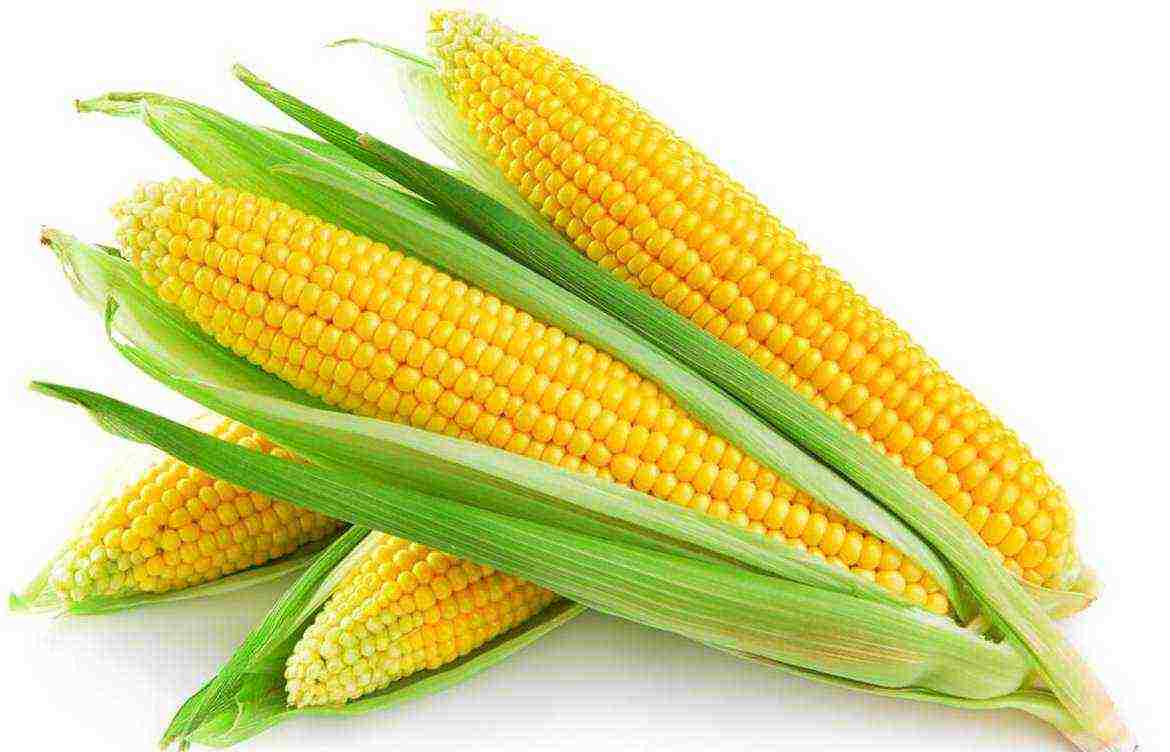 If the corn variety is prone to lodging or the area is windy, it is best to tie up the stems in advance, before the plant grows to full growth. Weeding is done as needed a couple of times during the sweet corn growing season.
If the corn variety is prone to lodging or the area is windy, it is best to tie up the stems in advance, before the plant grows to full growth. Weeding is done as needed a couple of times during the sweet corn growing season.
In addition to the above care measures, corn stepchildren should be removed. Leaving 2-3 ears for growth and development.
Pests and diseases of sweet corn
The most common diseases of sweet corn include:
Fusarium stem, seedling and cob, a fungal disease affecting young grains on the cob and stalk with a pale pink or grayish-gray bloom. The fight against the disease involves pre-sowing treatment of planting material, treatment of seedlings with fungicides and observance of corn crop rotation.
Putrid lesions of the stem and roots. It spreads fairly quickly over the entire surface of the plant. The reason for the precipitation is above normal, the boggy area, low temperature.
Damaging the leaves and stems with black and brown spots, leads to subsequent rotting and death of the culture. Treatment of plants with fungicides, observance of crop rotation and the sun's rays are able to rid the culture of the "infection". Remarkably, rot is rarely found in the south of the country; for the development of the fungus in full force, it needs a humid environment, constant dampness and shade.
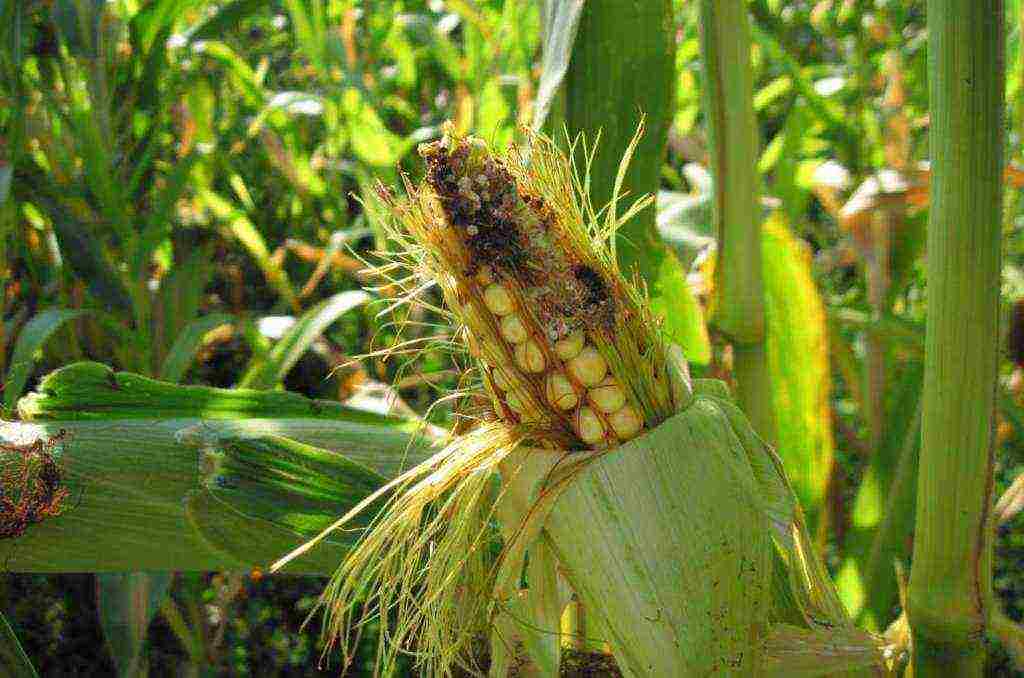 Rust. It affects both cobs and foliage with a stem.
Rust. It affects both cobs and foliage with a stem.
The causative agent is a fungus that actively develops in the summer months. The disease is contagious and difficult to remove. The appearance of yellow and brown spots on the surface of the leaf indicates infection; it is easier to pull out and burn such a plant, preventing it from spreading to other plantings. Non-infected plants are treated with antifungal drugs, Bordeaux liquid and copper sulfate. Observance of crop rotation and careful plowing of the site after harvest is necessary.
Dusty corn smut. The disease is widespread in the south of Russia. Affects the plant completely, including the cobs.
Has the ability to accumulate and multiply in the soil.
Pathogens are microorganisms that can destroy up to half of the crop. The affected plant lags behind in growth and development, if the ear is formed, then it turns black and decays over time, the disease leads to the inevitable death of corn.
It is not possible to achieve a complete cure of infected crops, therefore it is so important to observe crop rotation, treat seeds with fungicides before sowing and destroy the infected plant. To be safe, you can give preference to hybrid varieties that are resistant to head smut and strictly follow the rules of agricultural technology before planting.
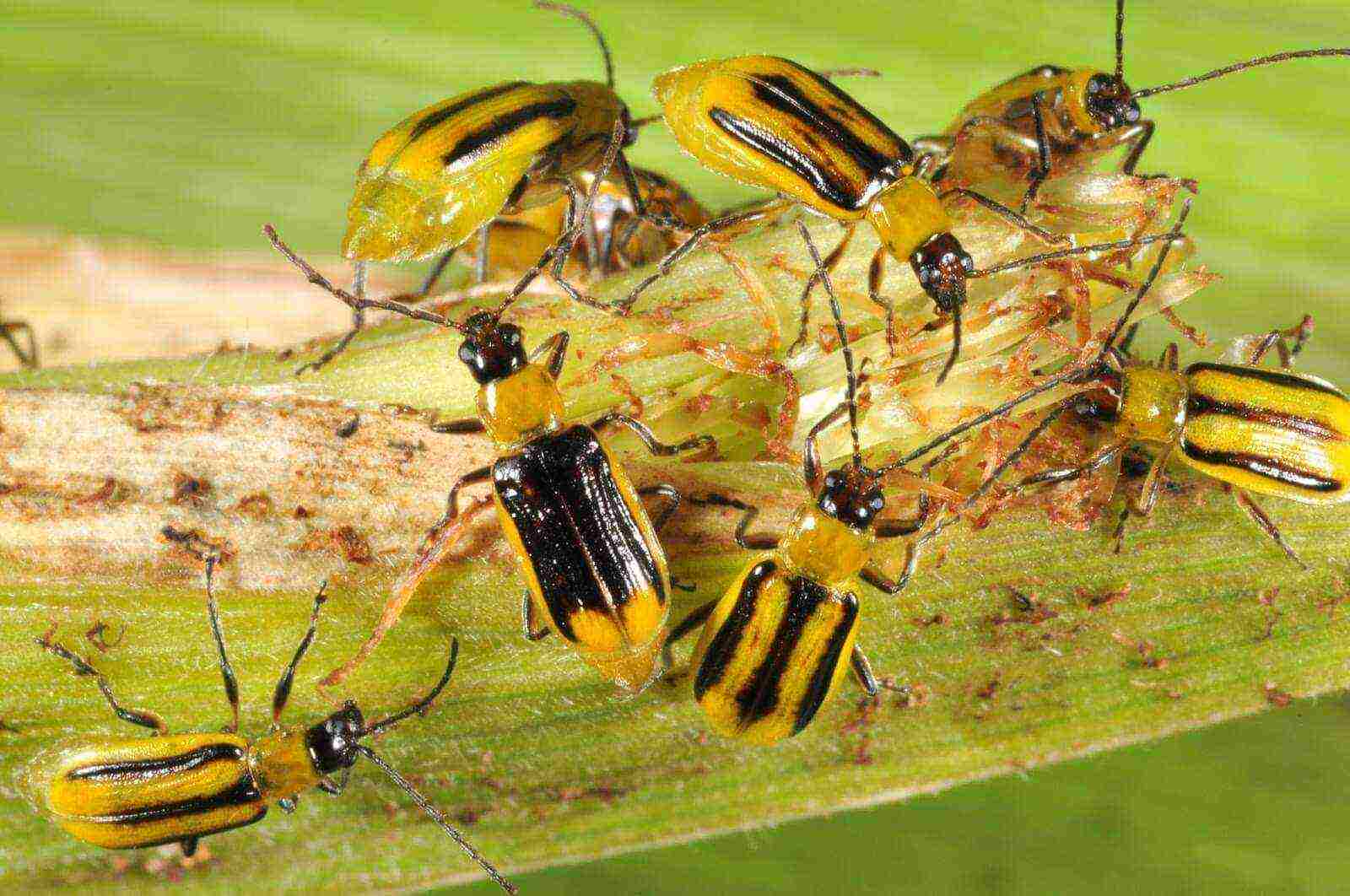 The most common maize pests: wireworms, leaf-eating insects, scoops, swedish oat fly, darkling beetle larvae, caterpillars, meadow moths, locusts. The listed insects in large populations are capable of spoiling, devouring crops and leaving them without a crop. Therefore, it is better to prevent their appearance.
The most common maize pests: wireworms, leaf-eating insects, scoops, swedish oat fly, darkling beetle larvae, caterpillars, meadow moths, locusts. The listed insects in large populations are capable of spoiling, devouring crops and leaving them without a crop. Therefore, it is better to prevent their appearance.
For this, plantings and soil are treated with protective biological preparations, entomophages (beneficial insects) are attracted to the site. It is necessary to observe crop rotation and carry out timely plowing of the site. If insects appear, then the treatment of plants with insecticides and the installation of pheromone traps will help.
Growing sugar corn is a laborious process, however, the taste of fresh homemade cobs will more than pay off the energy you spent.
Try not to get carried away with the "chemistry" in the cultivation process, and then, hot corn will bring you not only moral satisfaction, but also benefit.
Sweet large corn is one of the favorite dishes of almost everyone, a kind of pleasant memory from childhood, especially at the beginning of the summer season. A popular plant, a native of America, in ancient times was cultivated by the ancient Maya and Aztecs.
Corn is the slender queen of the fields
On an industrial scale, this crop is grown mainly for fodder purposes, but it has adequately found its niche in many summer cottages and garden plots, where corn varieties are presented in all their diversity. Moreover, home cultivation significantly "cultivated" the tall beauty, depriving her of the ability to self-seeding and growth in its former, wild state. 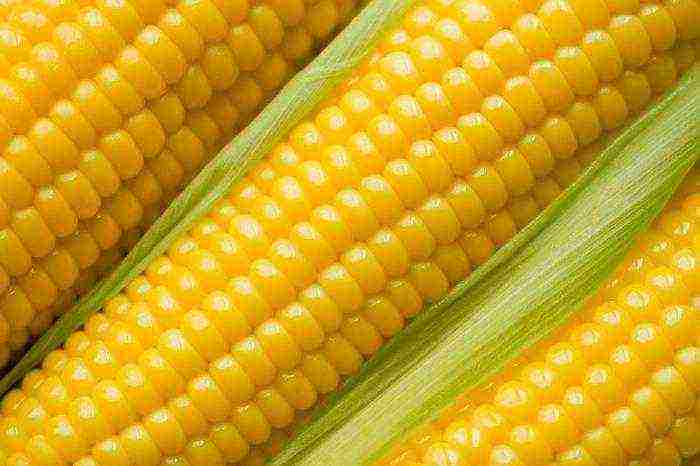 Now this culture is monoecious, has separate inflorescences and is cross-pollinated. Some gardeners use artificial pollination - for this they pluck the spikelets at the top of the stem (male flowers) and shake them over the flowering cobs (female-type flowers).
Now this culture is monoecious, has separate inflorescences and is cross-pollinated. Some gardeners use artificial pollination - for this they pluck the spikelets at the top of the stem (male flowers) and shake them over the flowering cobs (female-type flowers).
Description and external characteristics
The root system of almost every corn variety is quite powerful and goes underground to a depth of about 1.5 meters. Along the way, the formation of additional (supporting) roots on the stem is observed, causing a more dense fixation of the plant in the soil and contributing to the optimal absorption and retention of water and minerals.
The stems of the plant are erect, can reach 6 meters in height (depending on the type of corn). Male inflorescences are at the top of the stem in the form of panicles, while female ones are hidden in the leaf axils. The mass of such a complex ear, which is an ear of corn, ranges from 35 to 500 grams.
All existing varieties of corn are divided into several main types in terms of grain structure and direction of use. Below are the main ones in terms of varieties.
Sweet corn varieties
Sweet corn is the most popular and beloved, especially during the period of its milky-wax ripeness; a tasty ingredient in many salads, is the basis of many high-yielding hybrids. Upon reaching full maturity, corn accumulates a significant amount of sugars. The surface of the grains is wrinkled, they themselves are vitreous in section. Sweet corn is successfully used in the canning industry.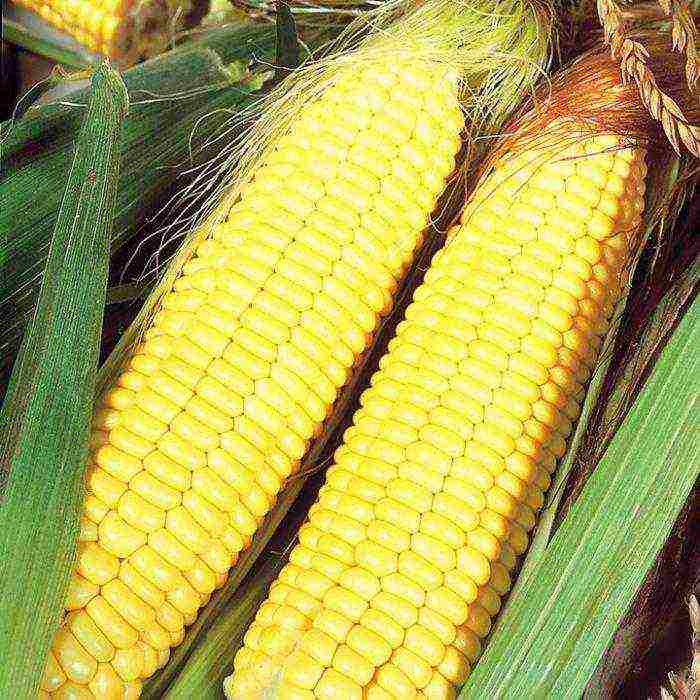
The most popular and popular varieties of sugar corn are Ice Nectar, Rannyaya Zolotaya 401, Spirit, Lakomka 121, Dobrynya, Sundance.
Spirit
It is a new hybrid and a striking representative of the sweet corn variety; suitable for almost all regions of Russia. It is characterized by grains of bright yellow color, which are collected in cobs up to 20 cm in size. The taste is soft-sweet (due to the high sugar content in the grains), the pulp is quite juicy. The plant is 2 meters high. When growing this variety by seedlings and planting in open ground at the end of May, Spirit corn will delight you with a high-quality harvest after 2 months.
Dobrynya
A hybrid characterized by early ripening. Planting is carried out in May, after 70 days you can collect ripe cobs. It has a sweet taste and impressive ears. Plant height is about 170 cm, the formation of cobs occurs starting from a height of 70 cm. Excellent for fresh consumption, freezing, canning. It grows in any soil and has good disease resistance.
Gourmet 121
The variety is characterized by high yields and resistance to various diseases. The growing season is 70-75 days. The height of the plant is about 1.5 meters. The length of the cob is up to 20 cm. At the stage of milk maturity, cobs of the Lakomka 121 variety are very tasty boiled, also used for freezing and preserving.
Ice nectar
A late-ripening variety characterized by excellent taste and good yield. Among the rest, it is considered the sweetest. Corn cobs can reach a length of 22 cm, which indicates their significant size.
Sundance
It has slightly elongated yellow grains that are great for canning and fresh consumption. On each bush, not tall in stature, two cobs up to 20 cm long and up to 5 cm in diameter are formed. This variety is sown at the end of May and ripens for 70-95 days.
Early Gold 401
This variety is short, with a growing season of about 90 days. High resistance to disease. Medium drought tolerance. The cob weight is up to 190 grams. Grain of yellow color with high taste characteristics.
Toothed corn: description and varieties
It is characterized by large ears, strong stems, high yield and good silage yield. In America, it is the main type of corn grown commercially and used for animal feed purposes. Its grains resemble a tooth in shape and at the top have a depression formed during ripening. Plants usually do not bush, the grain contains up to 75% starch and is used for the production of alcohol, flour and cereals.
Odesskaya 10 and Sterling are prominent representatives of dent-like corn varieties.
Odessa 10
A late-ripening variety that gives a significant yield of green mass and a low yield of grains. Most often grown for silage.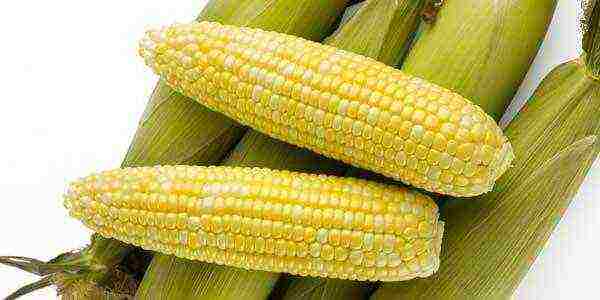
Sterling
A medium-late high-yielding variety, zoned in almost all areas of corn cultivation.
Flint corn: characteristics of varieties
It has a strong, smooth grain (without depressions, rounded on top), white or yellow, which is almost entirely composed of starch.This species serves as the basis for the production of corn sticks and flakes and is the most common on the planet. The crossing of such a subspecies of maize with a dentate led to the appearance of semi-dentate corn.
The most common are such varieties of corn as Voronezh 80, Voronezh 76, Severodakotskaya.
Voronezh 80
An early hybrid that ripens in 70 days. It is appreciated for its ease of maintenance and high sugar content. The size of the cobs is from 20 to 25 cm, the height of the plant is 170 cm. It is used in canning. Seeds for crops next year cannot be used. Zoned in the Sakhalin region and northern regions of Siberia.
Voronezh 76
Early ripening variety. It ripens in almost all regions of the central black earth zone.
Severodakot
Medium early grade. It is planted in the southern and southeastern regions of Russia.
Popcorn: Popcorn Varieties
Outwardly, the description of varieties of corn of this type is similar: the grains are smooth and shiny, burst when heated. It was this look that became the basis for the appearance of everyone's favorite popcorn. The plant is characterized by good bushiness, a large number of ears, and the presence of a significant number of leaves.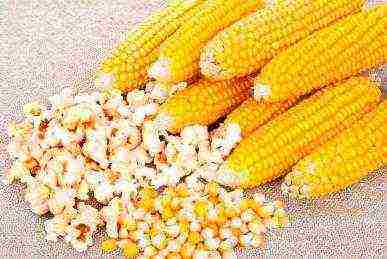 The best varieties of corn for popcorn are Volcano, Oerlikon, Dniprovskaya 925.
The best varieties of corn for popcorn are Volcano, Oerlikon, Dniprovskaya 925.
Volcano
It is characterized by excellent taste properties of toasted grain and its high percentage of increase. The variety of corn for popcorn is medium early, drought-resistant, high-yielding, plant height - up to 220 cm. The length of the cob is about 22 cm. It is grown in forest-steppe and steppe regions.
Oerlikon
Medium early variety, characterized by excellent taste and pleasant aroma. Used to make popcorn, cornflakes and sticks.
Other types of corn
- Waxy maize. Seeds of the variety of this subspecies are characterized by smoothness and dullness of the skin. In cross-section, the grain structure resembles wax. This species, whose varietal variety is rather limited, is very popular in China.
- Starchy corn. One of the oldest on the planet. Most common in southern North America and South American countries. Corn varieties (photos of the plant can often be seen on many specialized resources) are characterized by late ripening. Plants of medium height, many leaves, medium to strong bushiness. The grain is round, matte, smooth, has a convex top. Starch content - up to 80%.
- Filmy corn. In industry, this type is not used due to the complexity of processing, because not only the cob, but also each grain is covered with individual wrappers.
- Sharp (nose) corn. It has no special value, therefore it is not very common.
Fashionable novelty - Hopi corn
This variety of corn differs from the others and has its own flavor - an unusual, unusual black and purple color of the grains, caused by the presence of a special enzyme. 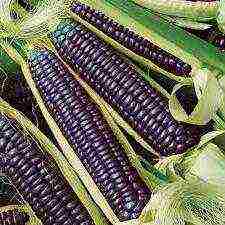 Mainly grown in the southwestern United States and northern Mexico. The taste is sweet and delicate, with a pronounced nutty flavor. This variety was found among the Hopi Indian tribes, which formed the basis of its name. It can be assumed that this is a very ancient type of plant, which was supplanted by the usual bright yellow or orange corn. This "purple" variety, which has many varieties of different colors, has taken a worthy niche in the consumer market and is widely used in cosmetology, in the manufacture of blue mixtures and corn chips. The popular alcoholic drink "Chicha Morado" is prepared on the basis of blue grains. There are many varieties of Hopi corn, the color range of which is quite wide: from light gray to almost black. Several colors can be combined in one ear, which makes these varieties of corn decorative.
Mainly grown in the southwestern United States and northern Mexico. The taste is sweet and delicate, with a pronounced nutty flavor. This variety was found among the Hopi Indian tribes, which formed the basis of its name. It can be assumed that this is a very ancient type of plant, which was supplanted by the usual bright yellow or orange corn. This "purple" variety, which has many varieties of different colors, has taken a worthy niche in the consumer market and is widely used in cosmetology, in the manufacture of blue mixtures and corn chips. The popular alcoholic drink "Chicha Morado" is prepared on the basis of blue grains. There are many varieties of Hopi corn, the color range of which is quite wide: from light gray to almost black. Several colors can be combined in one ear, which makes these varieties of corn decorative.
Fodder maize varieties
The fodder varieties of corn, the purpose of which is to obtain a significant amount of silage for feeding livestock, include such varieties as the Kuban early-ripening hybrid, Aurika, Viola, Saratovskaya sugar, Golden Fleece, Pearl. Fodder maize, the varieties of which are characterized by a high degree of leafiness, is also used to obtain high-quality grain.
Landing rules
It is advisable to plant corn in sunny places; she is not picky about the choice of soil, but still prefers light and well-warmed lands. The predecessors of a tall crop can be legumes, winter crops, row crops, and spring wheat. It can also be planted after tomatoes, root crops and melons.
Soil fertility plays a huge role in obtaining a rich and high-quality harvest, therefore it is imperative to carry out top dressing (organic and mineral). In the autumn digging into the ground, you can add rotted manure and phosphorus-potassium fertilizers. In the spring, before planting, the site is pre-leveled with a rake (to remove the surface crust and break up clods of earth). 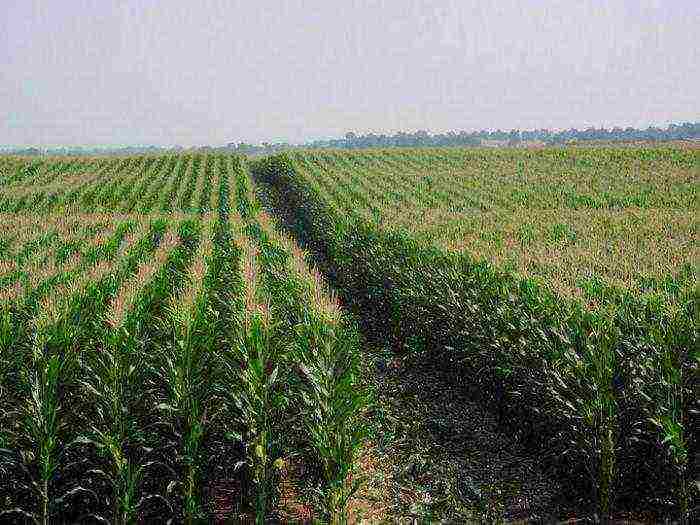
Planting corn should be done in soil warmed up to 12 ° C, this happens around the end of April; seeds are planted to a depth of about 7 cm.On the eve of planting, about a day before, it is recommended to apply nitrogen fertilizers (for 10 m2 - 200 grams) and loosen the soil to a depth of 10 cm.
Acceleration of seed germination can be ensured by preliminary soaking in warm water. To do this, they should be placed in a gauze bag, which is placed in a sunny place for 4 days, and then placed in a solution of potassium permanganate for 20 minutes. Then the seeds should be washed, placed in a container and placed in a warm place. After 3-4 days, small roots will appear, it is then that the seeds can be planted in open ground. In the field, the first shoots will delight about the 12th day.
Many amateur gardeners plant ready-made corn seedlings in order to obtain a harvest in a short time, which is usually 30 days old at planting.
Sowing corn is required in rows, the spacing of rows is 60 cm, between plants - 40 cm. Seeds are planted to a depth of 3-4 cm in a well-watered hole. Of the emerging seedlings, of which there may be several (since several seeds fall into the hole in order to ensure their germination), the strongest plant should be left, the rest should be disposed of.
When planting corn, you can use the conveyor method, that is, plants with different ripening periods can be planted at intervals of 15 days. This will ensure uninterrupted harvesting throughout the summer.
Plant feeding
Top dressing of corn should be done when the plant has six leaves. During this period, you can add compost, humus, mullein, chicken droppings. In addition to organic matter, between the rows, ammonium nitrate, superphosphate and potassium fertilizers are introduced in liquid form.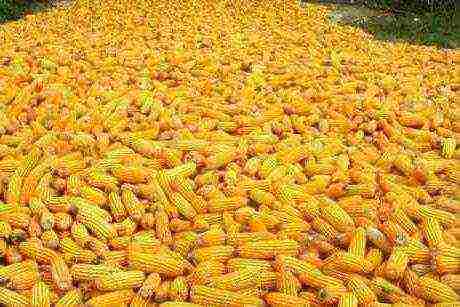
The lack of trace elements required by the plant can be determined by the appearance of the corn. When the leaves are short and pale, there is a lack of nitrogen; if in the early stages of plant development its slow growth is observed, and the edges of the leaves acquire a purple hue, it means that the culture does not have enough phosphorus. Abnormal waviness of the leaves and a change in their color (from pale to dark brown) indicate a lack of potassium.
Care features
After planting, the growth of corn is slow for some time, therefore it is required to carry out loosening and weeding (about 3 times during the growing season) in order to enrich the soil with oxygen and remove the upper earth crust. Intensive growth of maize begins after the appearance of the eighth leaf; during this period, the daily growth can be 5-6 cm. When lateral shoots - stepchildren - are formed in corn, the latter should be cut off so that they do not interfere with the development of young ears and plant growth.The reasons for the formation of unwanted side shoots can be low temperatures in the early stages of the growing season, excessive fertilization, as well as sparse sowing.
Watering corn, infrequent and abundant (water should penetrate to a depth of 10-15 cm), is required during the period of laying and ripening of young cobs.
Early Gourmet 121
Rannyaya Lakomka 121 - a variety of sugar (vegetable) corn of the selection of Innovative-Production Agrofirma "OTBOR" LLC, for orchards, household plots, tenants and farms. Included in the State Register of Breeding Achievements approved for use since 2005. Early ripening, FAO 140. The period from full germination to the beginning of technical ripeness is 60 - 65 days.
With proper care, the yield of the variety reaches 4.5 - 4.8 tons of cobs of milky-wax ripeness per hectare, the yield of conditioned cobs is 93%.
Plants are medium-sized, bushy. The ears are of medium cylindrical shape, up to 18 cm long, the number of grain rows is 12-14. The grain in milky-wax ripeness is yellow, the consistency is sugar. The weight of a conditioned ear is up to 150 g. The taste of the grain is excellent.
The seeds are of a sugar-like consistency, glassy, yellow-orange in color. The mass of 1000 seeds is 150 - 180 gr.
A very sweet variety characterized by an amazing taste and fast cooking (cook for 5-10 minutes). It has no equal among domestic varieties in the speed of ripening. A great treat for children and adults. Suitable for fresh, freshly boiled consumption and canning using green pea technology.
It is recommended to sow at the optimal time for the growing area. The plant density for irrigated areas and areas with sufficient moisture can be 60-65 thousand / ha, and on rainfed areas - 45-50 thousand / ha.
Sowing in areas infested with wireworms should not be carried out as sweet corn seeds are more susceptible to wireworm damage in the soil and field germination can be reduced by up to 50%.
The use of post-emergence herbicides can adversely affect the growth and development of plants, especially after the development phase - 3-5 leaves, therefore, it is better to use pre-emergence, soil herbicides on the crops of Early Lakomka 121.
